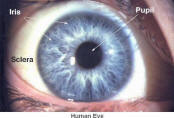Neurology Anatomy Physiology
December 14, 2021
Sences Organs
Information on Vision
continued from the Brain Page of Nervous System
Contents
neurons and Nervesneurotransmitter
The Brain & Spinal Cord
Cranial Nerves
Peripheral Nervous System
Autonomic Nervous System
Senses: Eye diagrams, Hearing, Smell, Taste, Taste & Tongue Sensation, Balance
Memory , Memory types, Creation of Memory,
Higher Functions
Altered States
[Top]
Continued from Brain
The general receptors distribute all over the skin. They are usually grouped together as sensation. The special receptors locate only at certain part of the body in the head. Altogether, they are referred to as the five senses. The followings present a further break down into components, and functions.
-
Sight (see location of the various
components in Figure 09):
- Sclera - This is the white of the eye. It is a tough whitish sheath covering most of the eye (see Figure 11). The inter-cellular space contains a kind of loose proteins composed of collagen and elastic fibers, which make the wall of the eyeball more pliant.
- Cornea - It is almost perfectly transparent at the front of the sclera for the protection of the eye. Light rays is refracted through this dome-shaped structure.
- Choroid - The soft layer inside the sclera. It has many blood vessels that nourish the eye. It also absorbs stray light.
- Ciliary body - The choroid becomes suspensory
ligaments near the opening. It holds the lens in place,
and controls the shape of the lens for near and far
vision.
- Iris - Further toward the opening, the choroid becomes a thin, circular, muscular diaphragm known as the iris, which regulates the size of a center hole (the pupil) and thus controls the amount of light entering into the eye. The pupil gets larger in dim light and smaller in bright light.
- Aqueous humor - This is the anterior cavity between the cornea and the lens. It is filled with an alkaline, watery solution secreted by the ciliary body. Normally, the solution leaves the anterior cavity by way of tiny ducts that are located where the iris meets the cornea. When a person has glaucoma, these drainage ducts are blocked, and aqueous humor builds up. The resulting pressure compresses arteries that serve the nerve fibers of the retina. The nerve fibers begin to die due to lack of nutrients, and the person becomes partially blind.

Figure 11 Human Eye
[view large image]
Powered by cidpusa.org